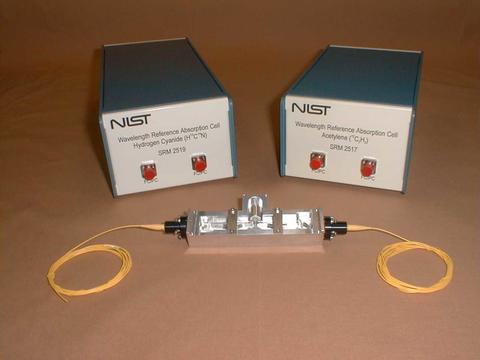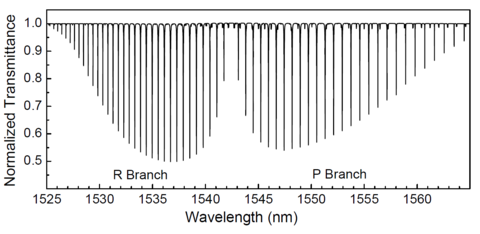Wavelength Standard Reference Materials (SRMs)

Figure 1. Typical Wavelength Reference Standard
The Applied Physics Division provides several types of Wavelength Reference Cells. A typical cell is depicted in Figure 1 and a typical absorption spectrum is depicted in figure 2. The absorption spectrum is realized by illuminating a cell at its operational wavelength by a tunable fiber coupled laser source and measuring the spectra with appropriate spectrographic instrumentation, typically a fiber coupled wave-meter or optical spectrum analyzer.

The primary documentation associated with an SRM is its certificate. This provides customers with sufficient information to know whether the SRM will meet their calibration and/or traceability needs, to understand its proper use along with storage and aging considerations, and to understand the basis for the statement of certified values and associated uncertainties. The documentation also provides a thorough technical basis for the SRM or provides references to where that information is available.
Select one of the SRMs described in the table below for more information including price, ordering information, an example certificate, and other supporting documentation. Please contact Bill Swann (bill.swann [at] nist.gov (bill[dot]swann[at]nist[dot]gov)) for additional information.
Table 1. Available Wavelength Reference Standards
| SRM # | Name | Brief Description | Order Info |
|---|---|---|---|
| 2514 | Wavelength Reference for 1560-1595 nm - Carbon Monoxide (12C16O) | Fiber-coupled molecular gas absorption cell with absorption lines in the WDM- L-Band between 1560 and 1595 nm | https://www-s.nist.gov/srmors/view_detail.cfm?srm=2514 |
| 2515 | Wavelength Reference for 1595-1630 nm - Carbon Monoxide (13C16O) | Fiber-coupled molecular gas absorption cell with absorption lines in the WDM- L-Band between 1595 and 1630 nm | https://www-s.nist.gov/srmors/view_detail.cfm?srm=2515 |
| 2517a | High Resolution Wavelength Calibration Reference for 1510–1540 nm Acetylene 12C2H2 | Fiber-coupled molecular gas absorption cell with narrow absorption lines between 1510 and 1540 nm | https://www-s.nist.gov/srmors/view_detail.cfm?srm=2517A |
| 2519a | High Resolution Wavelength Calibration Reference for 1530 nm - 1565 nm Hydrogen Cyanide H13C14N | Fiber-coupled molecular gas absorption cell with narrow absorption lines between 1530 and 1565 nm | https://www-s.nist.gov/srmors/view_detail.cfm?srm=2519A |
Resources
For quotes, inquiries, and shipping information:
NIST Office of Reference Materials
100 Bureau Drive, Stop 2300
Gaithersburg, MD 20899-2300
Phone: 301-975-2200
Fax: 301-948-3730
E-mail: srminfo [at] nist.gov (srminfo[at]nist[dot]gov)
For technical information:
Bill Swann
Applied Physics Division
Phone: 303-497-7381
E-mail: william.swann [at] nist.gov (william[dot]swann[at]nist[dot]gov)
For information about other NIST calibration services:
Calibration Administrators
Physical Measurement Laboratory
E-mail: calibrations [at] nist.gov (calibrations[at]nist[dot]gov)

